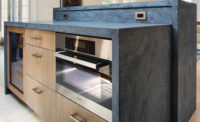Brian Briggs, Granite Guys, Inc., Ft. Pierce, FL:We used to cut slots in the stone and insert the lead anchors. Donny Taylor [a fabricator based in Albany, GA] did a step-by-step pictorial on how this is done, which can be found in the archives atwww.StoneAdvice.com.
About two years ago, I bought the T-31 Anchor Machine, and I am glad I did. We make a single saw kerf (this prolongs bit life and increases production rate) and then use the tool for the anchors. Once we are on the job, we silicone the sink, rest the sink where we want with a couple of bar clamps and a board, and then we slip in the bolts. We never rely on silicone alone; fasteners are always used (I have seen way too many failures with just using silicone).
- For stainless steel, granite composite, acrylic, Corian, etc., we use six clips and fasteners plus silicone sandwiched between the sink and the stone.
- For cast iron kitchen sinks, we build a cradle ¼ inch lower than the cabinet to hold the sink. (Be sure to install the sink before the countertop). Then we apply silicone to the rim of the sink and shim the sink up to the countertop.
- For farmhouse sinks, we require them to be set in place prior to templating. We then make the sink template with the sink hole in the template.
- For undermount vanity sinks, we use four clips and silicone. They are also the only sinks we overhang with the granite/marble.
- For vessel sinks, we require the faucet to be cut to a vessel sink cut out. Sometimes we inset the sinks so they do not sit so high up on the vanity. When this is done, we make the cut at an angle so that the bowl is resting on a flat edge as opposed to a corner.
We round all of our sink edges, which minimizes chipping by the customer, and on kitchen sinks, we do not overhang the stone into the sink. We stop the stone at the break of the edge in the sink. This eliminates the gap from an overhung sink that gets pretty nasty, and it enables the client to use whatever accessories the sink manufacturer has to offer. The bad part of this method is that your sink hole MUST be dead on and done right the first time. There is no room for error.
Jim Marshall, The Beveled Edge Marble & Granite, Westminster, MD:There are a lot of issues when it comes to installing sinks. One of the first things that we do is confirm that the sink will actually fit in the cabinet. Sometimes when you are dealing with a customer-supplied sink, the customer may not know the technical details involved to confirm this. We take into consideration many other things. Are there tip-out drawers involved? What type of stone is being used (some stones require larger margins because of their fragility)? Does the customer prefer a reveal or non-reveal installation? We bring all sinks back to the shop before fabrication. Sometimes the manufacturer's template will need to be modified because it does not match the sink the way it should. The layout is very important. If not done correctly, you might find the faucet handle hitting the window sill or bar overhang behind the sink and not functioning properly.
For installing sinks, we use several methods. Silicone and an anchoring device are always used. I like to use silicone with “bio guard†made by General Electric. This silicone helps prevent mildew or mold. Like Brian said, silicone should never be used alone without using some type of fasteners. Often, large garbage disposals are used that are very heavy. Silicone alone will never hold these applications. Rotoloc clips with 5-minute gel epoxy is our main method. These are available at some of the trade tool supply places. We also use Donny's slot method. I like this method because it is easy and very economical. Sometimes, a wooden cradle will be made to support heavy cast iron sinks. On any type of sink installation, I try to overkill whatever method I use. If you are using sink clips, then use more than needed. If it's a wooden cradle, then use glue and screws.
Jeff Leun, The Stone Haus Inc., Chattanooga, TN:We use mechanical anchors when setting stainless steel sinks. We cut a kerf as shown in Donny's pictorial onwww.StoneAdvice.com, except we insert fluted lead anchors filled with paste wax (to keep the epoxy from flowing inside them), fill with epoxy and shave down the next day. We've never had a failure. I can't tell you how many sinks I've been called to look at sitting at the bottom of a cabinet with nothing but glue left from the hack that installed it. Silicone is strong, but it won't hold a garbage disposal plus dishes and water. If you're doing it this way, stop and reorganize. Sinks attached in this manner just don't last.
Undermount sink cutouts are, for obvious reasons, the most hated part of fabrication. It typically takes us anywhere from two to three hours to install an undermount from start to finish. That hour of variation depends mostly on the shape of the sink. Straight line sinks are [simple], but bump outs with funky radiuses will slow things down a bit.
Our biggest problem with sinks is clients buying sinks that are 6 inches bigger than the cabinet box. Our policy is to never leave less than 3 ½ inches on the front rail of a sink. If it has to be less than that, the sink goes back for breakage liability reasons. We can accommodate some by cutting the cabinet, but we have to return some when it is unrealistic to make it work and not destroy the integrity of the box.
With cast iron sinks (my least favorite), we leave it to the cabinet guy to set, and we won't template until it is in place. On a remodel over existing cabinets, we make the exception and include an upcharge for building the cradle.
We do a 3/8-inch roundover on all box sinks. As Brian stated, it helps keep the homeowner from chipping the edge when tossing pots into the sink. We also like it for the simple fact that it cuts down on the prep work after the sink is cut out, since you only have to be concerned with the bottom ¾ inch of the edge inside. On farm sinks, we run whatever edge is on the rest of the top through the sink, regardless of what it is.
For vessel sinks and drop-ins, we cut the hole and leave the rest to the plumber.
>Donny Taylor, Albany, GA:I still cut slots for screws to anchor both stainless steel and china bowls (illustrated at StoneAdvice.com by visiting:www.stoneadvice.com/gallery/HOW-TO%21).
However, I use clear or color-matching latex adhesive caulk to bond between the rim and the stone. I have had to replace a sink or two before. In order to remove the sink, I had to get in the sink and drive several putty knives and wood shims around the rim to remove them. The latex bonds like mad after about a week of cure time.
As others have stated, never trust caulk or silicone alone to hold a sink in place. I can't begin to tell you how many I have re-attached due to that method.
On undermounts, we do the same as Brian and Jeff, with a small roll at the top to help prevent chipping, and it's a nice clean look as well.
The times have changed a lot in the industry today. Many fabricators are now selling sinks and faucets along with the tops. This is a real time saver, as well as another way to increase the bottom line. These days, a customer can purchase their tops, select a sink and faucet, and be assured that the sinks and tops will indeed work with each other in unison. Also, they have the convenience of providing the old “one stop shop.†No more running around from place to place to find the right sink and faucet for the kitchen, while hoping that the sink salesperson really understands how it fits in stone.
Ronald Hannah, Charlotte, NC:As the others have stated, it seems that we, the fabricator, have become responsible for everything (yes, including the kitchen sink). Part of our scope of work when templating is to ensure that the sink - whether stainless steel, cast iron or some mysterious granite composite - will, indeed, fit within the sink cabinet. We must also ensure that the faucet, spray head and soap dispensers selected will work in concert with the sink style being used. Sometimes we can modify the cabinet to suit the oversized sink. Sometimes the selection is just so wrong that we must become the bad guys and ask the customer to reconsider his/her selection. The coordination of these vital details has become our responsibility simply because it has to be done in order for us to proceed with the fabrication and installation of our stone.
Ninety percent of our jobs include undermount sinks and, while the actual mounting of undermount sinks is handled many different ways by each respective installer, the principle really comes down to two options: either suspend the sink from the stone or support the sink by the cabinet.
When suspending sinks from above, some installers use adhesives with clips, embedded anchors, DT V-slots with screws, and some (hopefully very few) rely on silicone alone.
When supporting sinks from below, we have seen wooden cradles, pre-fabricated adjustable steel brackets, reinforced cabinet rails and even “L†brackets fastened to the cabinet stiles.
Competent installers pretty much concur that a quality job will include a mechanical fastening system coupled with a silicone seal. (Use silicone or latex caulking as a sealant, not as the primary adhesive).
Completing the job requires a perfect caulk bead around the sink and granite joint. Here is where silicone can become your friend or foe. Too little and you will not have a complete watertight seal. Too much and you will have a sticky mess to deal with.
Remember, the customer ultimately spends more time in the sink area than anywhere else in their kitchen, so aim for perfection.




